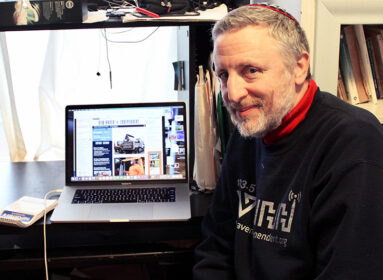By Dmitriy Shapiro/JNS.org/Washington Jewish Week
While there seems to be no argument on the size of the Anti-Defamation League’s newly published study on anti-Semitism, concerns have arisen about the accuracy of the survey’s findings on certain countries.
The “ADL Global 100,” released last week, measures anti-Semitic sentiments in 102 countries around the world and is considered the largest poll ever conducted on the subject.
“While this survey is but one additional tool in understanding and assessing anti-Semitism, now people around the world who care about combating anti-Semitism and hate have data which indicates where the problems are and where we need to focus attention,” Michael Salberg, ADL director of international affairs, told JNS.org.
Using the same survey that has for 50 years guided its research in the U.S., the ADL, in partnership with Anzalone Liszt Grove Research, asked 53,100 people to answer a set of 11 questions based on common anti-Semitic canards. Questions related to respondents’ perception of Jewish financial power, loyalty, media control, and the Holocaust. If respondents said at least six of the 11 statements were true, they were considered anti-Semitic. Based on that standard, the survey found that 26 percent of respondents worldwide held anti-Semitic beliefs.
Unsurprisingly, the Middle East and North Africa was the region with the highest concentration of anti-Semitism, at 74 percent. Within that region, the West Bank and Gaza had the highest number of respondents, 93 percent, surpassing the anti-Semitic threshold.
Experts who spoke to JNS.org about the survey were supportive of ADL’s efforts, but had concerns about the accuracy of some of the findings.
Many countries ADL ranked among the least anti-Semitic are in northern Europe. Sweden was the third-least anti-Semitic nation in the survey, at 4 percent, and the Netherlands was the fourth lowest, at 5 percent.
Rabbi Abraham Cooper, associate dean of the Simon Wiesenthal Center, finds those figures to be odd. He noted that the Swedish city of Malmo, which is home to about 700 Jews, has for the past few years been on the Wiesenthal Center’s “do not travel” list.
“You’re talking about countries in which shechita (kosher slaughter) is illegal, in which there are Holocaust deniers and generally very negative attitudes [about Jews],” Cooper said. “Jewish kids in schools in Scandinavia are bullied because they’re Jews. So the idea that Sweden is somehow that shining beacon in Scandinavia, it’s just way off.”
Cooper also mentioned efforts in neighboring northern European countries—with similarly low anti-Semitism concentrations in ADL’s survey—to ban circumcision.
Manfred Gerstenfeld, a Dutch-educated Israeli author and former chairman of the steering committee of the Jerusalem Center for Public Affairs, similarly took issue with the findings on Sweden and the Netherlands.

Members of the Swedish Resistance Movement, a neo-Nazi organization, take part in a nationalist demonstration in Stockholm in June 2007. Credit: Peter Isotalo via Wikimedia Commons.
“The problem is that anti-Semitism of course doesn’t express itself only through prejudices. It also expresses itself through acts, and this study gives you no insight into that,” said Gerstenfeld, citing a 2013 study by the European Union Agency for Fundamental Rights in which 60 percent of Swedish Jews interviewed saw anti-Semitism as a very big or fairly big problem in their country.
Gerstenfeld – the author of Demonizing Israel and the Jews, a 2013 book on modern anti-Semitism—said another problem the ADL poll neglects is anti-Israel sentiment.
The poll only mentions Israel once, when it asks if respondents believe Jews are more loyal to Israel than their own country. That statement received the highest percentage of affirmative answers across regions, with an average of 41 percent.
“In the Netherlands, 39 percent of the population thinks that Israel is running a war of extermination against the Palestinians. A genocidal war,” Gerstenfeld told JNS.org.
“Now I don’t need 11 questions on prejudices, this single question is enough to define somebody as an extreme anti-Semite. … If you are against the [Israeli] settlements you are not an anti-Semite. If you say Israel is a Nazi state, then you are an extreme anti-Semite,” he said.
Another problem with drawing conclusions from the ADL poll can be attributed to differing perspectives on whether an affirmative answer to a particular question is actually a reflection of personal Jew-hatred.
“[With] questions about Jewish power or influence, I think one of the things you find is how people in these surveys enormously overestimate the number of Jews in their country or in the world,” said Rabbi Andrew Baker, director of international Jewish affairs for the American Jewish Committee. “But the reality probably is, in many areas Jews certainly have an influence well beyond their number in society, so is someone reflecting a certain reality that we ourselves recognize or is someone expressing an anti-Jewish sentiment?”
The poll shows low averages for anti-Semitism in Asia, with one exception: South Korea, whose 53-percent concentration of anti-Semitism was well above the regional average of 22 percent. Baker explained that South Koreans have an intense curiosity about Jews, and that they make up the largest number of visitors to Europe’s Holocaust museums and sites of former concentration camps. In that way, canards the survey considers signs of anti-Semitism can be considered cultural aspirations outside of the Western world, according to Baker.
Yet despite the criticisms, experts agree that ADL’s survey should serve as a baseline for understanding world anti-Semitism. In Gerstenfeld’s estimation, the study “confirms what we have known, [what] is being hushed up by all kinds of whitewashers of [the anti-Semitism of] Muslims.”
“We are being told, and the administration in the U.S. is part of [it], that you have radical Muslims and then you have perfectly moderate Muslims, and [the moderates] are the majority and they are two distinct groups,” he said. “That is nonsense! I have been saying that for years and this study proves it. The truth is that there is a broad range of Muslim gradations, with very radical ones and moderates at the two extremes.”
The Wiesenthal Center’s Cooper believes that at the very least “it’s important that the ADL did the report,” and that the results should be a call to the Jewish community to unite against anti-Semitism. In a Jewish world often divided along denominational, political, and ideological lines, the survey might be “an important building block” in getting Jews to understand that “we have a lot of enemies out there,” he told JNS.org.
AJC’s Baker compared the ADL survey to an “enormous panorama photo with so many countries.”
“Thinking back to when my kids were in high school, there was always a class photo,” he said. “They’d have all these kids on a set of risers, maybe there’s 300 of them, and this special panoramic camera that could capture all of them. It’s a great picture, but if you’re really looking for your own kid, you’ll do much better if you have your own photos.”
According to ADL’s Salberg, studies with narrower focuses may indeed be in the cards.
“We might survey a few countries each year or every few years,” he said. “We are discussing it.”
This article is exclusive to JNS.org.








 Southern New England Jewish Ledger
Southern New England Jewish Ledger









